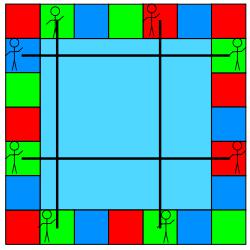Skip over navigation



Or search by topic
Number and algebra
Geometry and measure
Probability and statistics
Working mathematically
Advanced mathematics
For younger learners
Ribbon Squares
Age 7 to 11
Challenge Level 





Imagine a square swimming pool with 24 single tiles around it, like the one in the diagram.
Two children stand on different tiles, and hold a ribbon or ribbons across the pool.
Each child can hold one or two ribbons at a time.

Each ribbon runs from the middle of the tile that the child is standing on.
The children are trying to make squares with their ribbons that they call 'ribbon squares'.
Here's a ribbon square they made. It has an area of 9 square tiles.

What are the smallest and largest ribbon squares they can make?
How many differently sized ribbon squares can they make?
What happens if the square swimming pool is made from 20 tiles?
How many ribbon squares can they make then?
This problem featured in a preliminary round of the Young Mathematicians' Award.
Two children stand on different tiles, and hold a ribbon or ribbons across the pool.
Each child can hold one or two ribbons at a time.

Each ribbon runs from the middle of the tile that the child is standing on.
The children are trying to make squares with their ribbons that they call 'ribbon squares'.
Here's a ribbon square they made. It has an area of 9 square tiles.

How many differently sized ribbon squares can they make?
What happens if the square swimming pool is made from 20 tiles?
How many ribbon squares can they make then?
This problem featured in a preliminary round of the Young Mathematicians' Award.
You may also like
Geoboards
This practical challenge invites you to investigate the different squares you can make on a square geoboard or pegboard.
Tiles on a Patio
How many ways can you find of tiling the square patio, using square tiles of different sizes?
Pebbles
Place four pebbles on the sand in the form of a square. Keep adding as few pebbles as necessary to double the area. How many extra pebbles are added each time?

